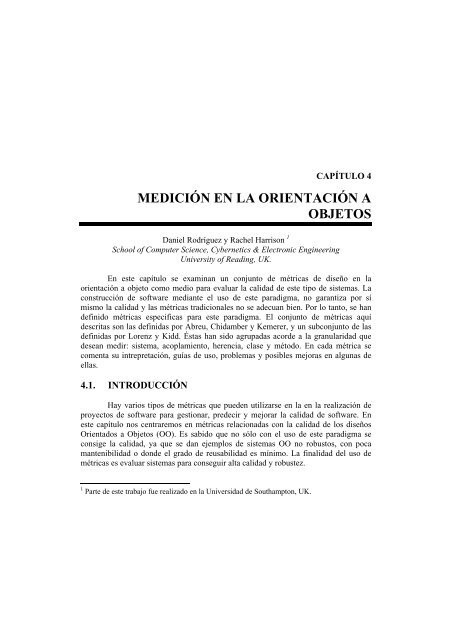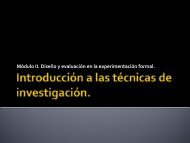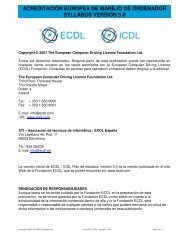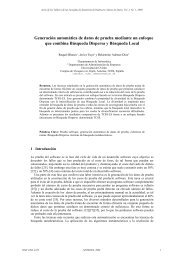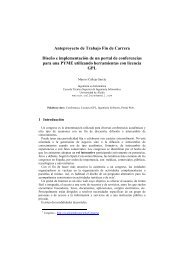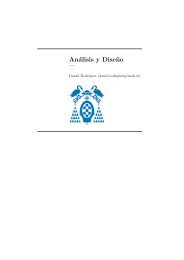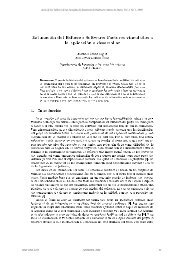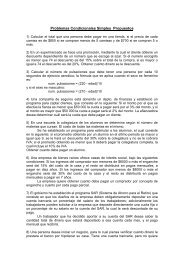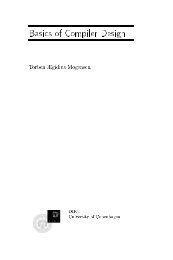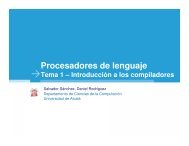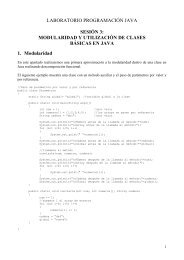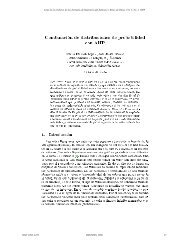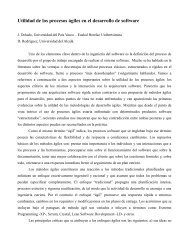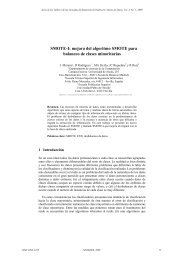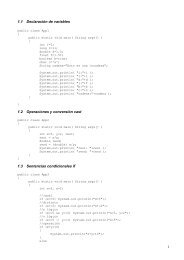MEDICIÓN EN LA ORIENTACIÓN A OBJETOS
MEDICIÓN EN LA ORIENTACIÓN A OBJETOS
MEDICIÓN EN LA ORIENTACIÓN A OBJETOS
You also want an ePaper? Increase the reach of your titles
YUMPU automatically turns print PDFs into web optimized ePapers that Google loves.
10 <strong>MEDICIÓN</strong> PARA <strong>LA</strong> GESTIÓN <strong>EN</strong> <strong>LA</strong> ING<strong>EN</strong>IERÍA DEL SOFTWARE © RA-MA1996] encontraron una correlación positiva entre DIT y el número deproblemas emitidos por el usuario, poniendo en duda el efectivo usode la herencia.Lorenz y Kidd sugieren un umbral de 6 niveles como indicador de unabuso en la herencia tanto en Smalltalk como en C++.Sistemas construidos a partir de frameworks suelen presentar unosniveles de herencia altos ya que las clases son construidas a partir deuna jerarquía existente. En lenguajes como Java o Smalltalk, lasclases siempre heredan de la clase Object, lo que añade uno a DIT.Los problemas con esta métrica se deben a las diferentescaracterísticas de la herencia, ya que DIT no queda claramentedefinida y no puede verse como una medida de reuso. Puedefácilmente imaginarse clases con gran profundidad en la jerarquíareusando menos métodos que en una clase poco profunda pero muyancha.Número de hijos.(Number of Children –NOC-) [Chidamber y Kemerer, 1994]DefiniciónPropósitoGuías ycomentariosNOC es el número de subclases subordinadas a una clase en lajerarquía, es decir, el número de subclases que pertenecen a unaclase.Según Chidamber y Kemerer, NOC es un indicador del nivel dereuso, la posibilidad de haber creado abstracciones erróneas y es unindicador del nivel de test requerido.Aunque un mayor número de hijos representa una mayorreutilización de código, presenta los siguientes inconvenientes:• Mayor probabilidad de usar incorrectamente la herencia creandoabstracciones erróneas.• Mayor dificultad para modificar una clase ya que afecta a todoslos hijos que tienen dependencia con la clase base.• Se requiere mayor número de recursos para testear.Es un potencial indicador de la influencia que una clase puede tenersobre el diseño del sistema. Si el diseño tiene una alta dependencia enla reusabilidad a través de herencia, puede ser mejor dividir lafuncionalidad en varias clases.Índice de especialización por clase.(Specialisation Index per Class –SIX-) [Lorenz y Kidd, 1994]DefiniciónEl índice de especialización muestra en que medida las subclasesredefinen el comportamiento de sus superclases.Nº de metodos redefinidos ⋅ Anidamiento en la jerarquíaSIX =Nº total de metodos
© RA-MA CAPÍTULO 4: <strong>MEDICIÓN</strong> <strong>EN</strong> <strong>LA</strong> ORI<strong>EN</strong>TACIÓN A <strong>OBJETOS</strong> 154.5. CONCLUSIÓNSe han descrito un conjunto de métricas para diseños orientados a objeto,dando guías y umbrales para su interpretación como un medio para producir sistemasde calidad. Se comentan también algunos de los problemas que podemos encontrarnosal analizar las métricas, como definiciones ambiguas que dan lugar a variasinterpretaciones, la falta de concordancia para el propósito que fueron concebidas eincluso la falta de validez teórica.Todo esto hace ver que es necesario más trabajo en el campo de las métricasorientadas a objetos y en su validez tanto teórica como experimental. Así mismo, esnecesario tener unas normas más claras para la interpretación de las métricasbasándose en el sentido común y en la experiencia.4.6. REFER<strong>EN</strong>CIAS[Abreu y Melo, 1996] Brito e Abreu F., Melo W. “Evaluating the impact of Object-Oriented Design on Software Quality”. Proceedings of 3rd InternationalSoftware Metrics Symp., Berlin, 1996.[Archer y Stinson, 1995] Archer C., Stinson M. “Object-Oriented SoftwareMeasures”. Technical Report CMU/SEI-95-TR-002, Abril 1995.[Basili y Rombach, 1988] Basili V. R., Rombach H. D. “The TAME Project: TowardsImprovement-Oriented Software Environments”, IEEE Transactions onSoftware Engineering, Vol. 14, No. 6, Junio 1988.[Basili et al. 1995] Basili V. R., Briy L., Melo W. “A Validation of OO DesignMetrics as Quality Indicators”, Technical Report CS-TR-3443, 1995.[Cartwright y Shepperd, 1996] Cartwright, M., Shepperd, M. "An EmpiricalInvestigation of Object Oriented Software in Industry", Dept. of Computing,Talbot Campus, Bournemouth University Technical Report TR 96/01, 1996.[Chidamber y Kemerer, 1994] Chidamber S. R., Kemerer C. F. “A metric suite forszobject oriented design”, IEEE Transactions on Software Engineering, pp.467–493, 1994.[Chidamber et al. 1998] Chidamber, S. R., Darcy D. P., Kemerer C.F. “Guides ofobject oriented software metrics: an exploratory analysis”. IEEE Transactionson Software Engineering, 24(8), pp. 629-639, Agosto 1998.[Daly et al. 1992] Daly J., Brooks A., Miller J., Roper M., Wood M. “Evaluatinginheritance Depth on the Maintainability of Object-Oriented Software”.Empirical Software Engineering 1(2), Febrero 1996.[Fenton y Pfleeger, 1997] Fenton N. E., Pfleeger S. L. Software Metrics. A rigorousand Practical Approach. 2nd Edition. ITP, International Thomson ComputerPress, 1997.[Fenton, 1994] Fenton N. E. “Software measurement: a necessary scientific basis,”IEEE Transactions on Software Engineering, Vol. 20, no. 3, pp. 199–206,1994.[Harrison et al. 1997] Harrison R., Counsell S., Nithi, R. “An Overview of Object-Oriented Design Metrics”. Proceedings of 8th IEEE International Workshop
16 <strong>MEDICIÓN</strong> PARA <strong>LA</strong> GESTIÓN <strong>EN</strong> <strong>LA</strong> ING<strong>EN</strong>IERÍA DEL SOFTWARE © RA-MAon Software Technology and Engineering Practice - (STEP'97), London, UK,Julio 1997.[Harrison et al. 1998] Harrison R., Counsell S., Nithi R. “An evaluation of the MOODSet of Object-Oriented Software Metrics”. IEEE Transactions on SoftwareEngineering, Vol. 24, No. 6, Junio 1998.[Harrison et al. 1999] Harrison R., Counsell S., Nithi R. “Experimental Assessment ofthe effect of inheritance on the maintainability of Object-Oriented systems”.Proceedings of Empirical Assessment in Software Engineering (EASE'99),Keele, UK, 1999.[Henderson-Sellers, 1996] Henderson-Sellers, B. Object-Oriented Metrics Measuresof Complexity. Upper Saddle River, NJ: Prentice Hall, 1996.[Kitchenham et al. 1986] Kitchenham B. A., Walker J. D., y Domville I. “Testspecification and quality management - design of a QMS sub-systemforquality requirements specification”, Project Deliverable A27, Alvey ProjectSE/031, Noviembre 1986.[Kitchenham et al. 1995] Kitchenham B. A., Pleeger S. L., y Fenton N. “Towards aFramework for Software Measurement Validation”. IEEE Transactions onSoftware Engineering, Vol. 21, No. 12, pp 929-944, Diciembre 1995.[Lorenz y Kidd, 1994] Lorenz M., Kidd J. Object Oriented Metrics. Englewood, NJ:Prentice Hall, 1994.[McCabe, 1976] McCabe, T. J. "A Complexity Measure", IEEE Transactions onSoftware Engineering, 2(4), 308-320, 1976.[Schneidewind, 1992] Schneidewind N. F. “Methodology for validating softwaremetrics,” IEEE Transactions on Software Engineering, Vol. 18(5), pp. 410–422, 1992.


